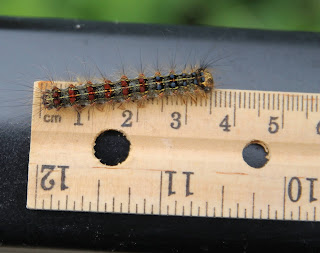2022
They have a new name: spongy moths! They are officially the Lymantria dispar dispar (LDD) moths. It's the caterpillars that give the most trouble.
In the winter, I noticed the spongy stuff on the trees. I couldn't possibly remove them all.
May 8th – see post: I brought some up to the house. The ones above the snow line did not hatch.
May 13th, there was a report on the nearby lake of the first instar.
May 16th – the first sign of them here. I only found a few. Whew!
May 30th – people on the lake sprayed BTK.
2021
LDD moth update! Ontario Natural Resources and Forestry has posted their map of areas defoliated by the LDD moth in 2021 across Ontario. Their findings are based off aerial forest health surveys and ground surveys.
I was correct to be worried. They are everywhere. Lymantria dispar dispar (LDD) moth caterpillars, otherwise known as European gypsy moth caterpillars. ("Gypsy" is politically incorrect, as it is considered a pejorative term, a racial slur. Gypsies, known as Romani or Roma, were called such, as Europeans thought they came from Egypt.)
- Monday, May 16th began the assault. I kept on washing off the railings. Every few hours, with soap in the water. They were all over the back deck📹. (4 mm)
- Thursday, May 20th – Apps and technology for fauna and the skies, on the railings and in the rain gauge. I cannot spray them, as we've gray tree frogs everywhere.
- Friday, May 21 – they are on the elm tree in the meadow
- May 21 – Chores, Butch, ducklings, and crow<= more on the railings.
- May 22 – regular washing down of the railings.
- May 23 & 24 – all over my rose bushes, elm trees 6 mm.
- Third and 4th instars: Gramma Camp – continued...Week 30 13 and 18 mm.
- May 29 – Blackflies, fallen tree, LDD 15 mm.
- May 31 – They are up to 19mm.
- June 6 – They are increasing in numbers, on the aspen, spruce, elm and birch. Sunday chores!
- June 9th – roses, rhodos, spruce tree, pines: Gramma Camp – Week 31
- June 10 – Backyard trees, pine trees: Gramma Camp – Week 31 32 mm.
- June 11 – up to 35 mm.
- June 18 – now 42 mm long. Chipmunk was eating them! One day at a time
- Reported on the lake: They are displaying a familiar inverted V-shape, which means they have been killed by the virus. I am a wreck!
- Thursday vs. Monday (photos below) the trees are growing new leaves. The caterpillar poop, and the fallen leaf parts, will fertilize the land.
- July 1st – they are pupating. Hopeful article re: fungus and viruses.
- July 9th – there are moths everywhere📹.
- July 15 – Stewart Park




The up side of having multiple years of high caterpillar population is that the virus that reduces their population (multicapsid nuclear polyhedrosis virus or LdMNPV) is now becoming quite established in the local ecosystem and, despite the thousands of egg masses and the tens of thousands of tiny hatchlings I saw this spring, the damage to the trees is far less than I was expecting this summer.
From Ontario Parks... regarding the LDD infestation.
While insecticidal sprays do exist, they are very expensive, and there are no available insecticides for broad-scale use that target only LDD Moths. Bacillus thuringiensis (or Btk), the product commonly used to control LDD Moth outbreaks, can kill all Lepidoptera (butterflies and moths) that are caterpillars when the spray is applied, usually in June.
Ottawa Valley – Wed., May 26, 2021


2020
- Aug. 14, 2020 – First eggs I've spotted at Foley Mountain Wednesday afternoon at Gramma Camp
- Sept., 2020 – Painting the decks, back to school, trailcams
LDD moths <=Ottawa Citizen
Ontario’s Ministry of Natural Resources and Forestry estimates caterpillar defoliation increased a staggering 1,200 per cent last year, from 47,203 hectares in 2019 to 586,385 hectares in 2020. Aerial surveys and ground searches for gypsy moth egg masses show this year’s infestation could be even worse.
Each egg mass can contain 100 to 500 eggs. These are the egg masses I spotted last year. I scraped them off and put them in soapy water. With 16 acres, there is no way I can keep that up. [Painting the decks, back to school, trailcams]


We visited Foley Mountain Park last year. The moth eggs were all over the trees.


Well, they have hatched. I noticed them Monday, May 17th. They fling themselves out into the world on gossamer threads, and their 4 mm bodies are spread on the wind.
gypsy moth caterpillars from Jennifer Jilks on Vimeo.
















No comments:
Post a Comment